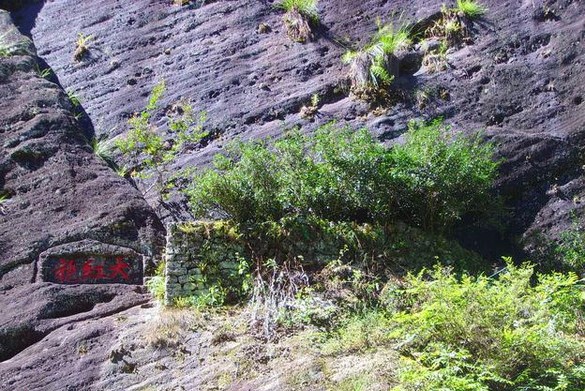Da Hong Pao (translated as “Big Red Robe”) is one of the most famous and exclusive teas in the world. As the most famous Chinese oolong tea, Da Hong Pao represents the essential character of rock oolong tea from Wuyi Mountain. It is a long leaf oolong tea with a sweet aroma, a unique woodsy character and fruity muscatel tones. It has a robust taste, but generally no bitterness.

Though Da Hong Pao is a variety of the Camellia sinensis tea plant, this variety is usually believed to be a wild variety. The variety has naturally adapted to the rocky cliffs of the Wuyi Mountains in northern Fujian, rather than a cultivated variety created by tea farmers. Wuyi mountain has unique geographical and climate conditions that give Da Hong Pao its unique characteristics. There is a large difference in temperatures between daytime and nighttime and the daylight hours are short. The are also has clear water springs that feed the tea bushes. The particular terroir of this area is key to the flavor of this distinct style, with the rocky, iron-rich soil providing unique minerals to the plant during the growth process.
Methods of crafting in this region have been perfected over several centuries to complement the natural flavor profile created by native varieties and terroir. Most Wuyi oolong teas are heavily roasted over a charcoal fire to produce a dark color and caramelize the glucose present in the leaf in order to create natural sweetness. Lower grades are roasted with modern convection ovens that make it easier to craft in larger batches. Traditionally roasted over charcoal in a process that lasts months, its bold red infusion has a layered mineral body with a sweet, enduring finish.

About six of the original ancient trees are still alive today and are growing on a cliff in the Wuyi Nature Preserve. An inscription on the cliff face reads “Da Hong Pao”, touting these trees as the original source of this famous Chinese tea. For many years, the extremely limited harvest plucked from these trees was reserved for China’s most elite tea drinkers and honored guests. In 1972, the tea was presented to American President Nixon when he visited China.
In 2002, 20 grams of tea were harvested from what are believed to be the original bushes and fetched a price of about $30,000 USD at an auction, making Da Hong Pao the most expensive tea in the world. Since 2006, harvesting from these trees has been banned, and “true” Da Hong Pao comes only from clippings of the original bushes, resulting in similar grades.
Legend
As one of the most famous teas in China, Da Hong Pao is surrounded by myth and legend. Fantastic stories have helped to build this tea’s reputation as a rare and valuable commodity.
Once upon a time, a scholar on his way to take the civil service exam stopped to brew some leaves plucked from a wild tea tree. He was the number one in his year to pass the rigorous test. After being awarded the prestigious red robe from the emperor, he returned to the tea bush to drape the robe over it for appreciation.

Another legend is about an ailing Ming dynasty emperor. While travelling through the area, he became ill and seemed on the verge of death. No remedy was able to improve his condition, until monks from a nearby monastery offered him a cup of tea made with leaves from a nearby bush. The emperor made a miraculous recovery and was so grateful that he offered his Da Hong Pao (his Big Red Robe) to protect the bush from the cold winter. Since then it has become known as the “Tea of the Immortals”.
Types of Da Hong Pao
These are the three types of this oolong tea that are found on the market.
Mother Tree Da Hong Pao
These are the original bushes and only 6 remain today, 3 of which date back to the Song Dynasty. Because there are only six, the tea from these bushes is incredibly rare and the most expensive tea on earth. Since 2006, harvesting from these trees has been banned.
Purebred Da Hong Pao
Back in the 1980s, researchers from the Fujian Academy of Agricultural Sciences started taking cuttings from the mother trees to reproduce them asexually. They succeeded. These new bushes are basically identical to the original ones, even after many generations and in 1988, tea experts judged tea from these “clone” bushes to be equal to tea from the mother trees. Three Wuyi varieties are commonly recognized as close relatives of the “original” Da Hong Pao trees: Bei Dou, Que She and Qi Dan, which is thought by some to include a few of the mother trees. All three are claimed as direct descendants of the mother plants, grown and developed from cuttings on tea farms within the Wuyi mountains to preserve the terroir of the original tea.
Naturally, this led to an explosion of Big Red Robe production, with over 40,000 acres of land currently being dedicated to purebred production. The bushes do not grow tall and are basically shrubs that spread out to a crown on top. Their branches are thick and the leaves have a wide oval shape with a shiny green color.
Commodity Da Hong Pao
Because demand for this tea was far higher than even the purebred bushes could provide, the Tea Research Institute of Wuyi Mountain began experimenting with blends. They combined purebred Red Robe with other Wuyi rock teas, like Rou Gui or Shui Xian. The result was very well received. Consumers loved the color and flavor of this “commodity dahongpao”.
Good blends have a mellow flavor and great rich fragrance, but they do not taste strongly like any of the teas included in the blend. That is important. The big problem when buying Da Hong Pao is that most of the poor quality teas grown on Wuyi mountain are also labeled as this tea, but they are far inferior. It is thus quite difficult to determine whether a tea you buy is a commodity Big Red Robe or just a low-quality tea grown in the same area.

Preparation
Da Hong Pao Tea is best brewed in a porcelain vessel, like a simple Ceramic Gaiwan or in a traditional Yixing, a teapot made from a purple clay. Here are the brewing instructions:
- Fill both the teapot and the cup about halfway with hot water to preheat them. Tilt them a bit so that the water creeps up the side and then rotate them so the insides get wet all the way around. Then pour the water out.
- Put 2 teaspoons of around 8g tea leaves into the teapot. If using a different vessel, use 2 teaspoons for every 236 ml of water.
- Fill the teapot with 100ºC (212ºF) water.
- Place the lid on the teapot and let the tea steep for 30-50 seconds for the first steep. Next, simply add 10-30 seconds more to each of your following steeps. This will allow you to experience the full range of tastes.
- Pour the tea into the teacups and enjoy your tea!
- You can get 4-6 infusions out of most varieties. The times for infusions you do depend entirely on your taste.

